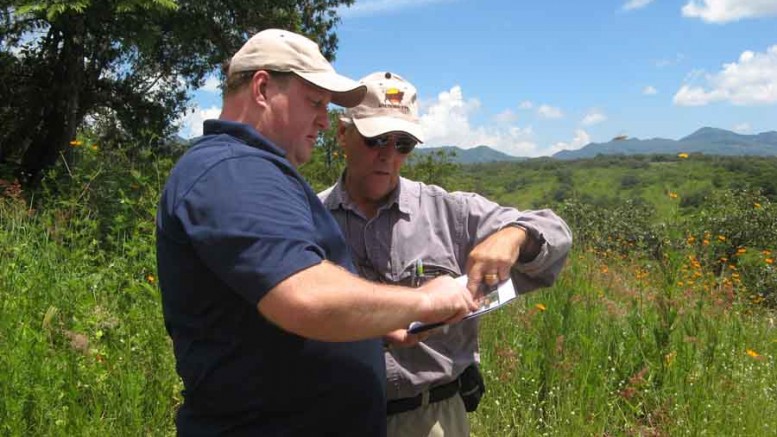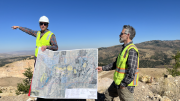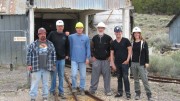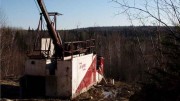It’s not every day that a primary silver deposit is found at the side of a road.
But that’s exactly what happened when Soltoro (SOL-V) identified a hematite-stained outcrop bursting with silver mineralization on the outskirts of Guachinango, a Mexican town of 3,000 people about 150 km southwest of Guadalajara, and 250 km east of Puerto Vallarta in Jalisco state.
Steve Priesmeyer, Soltoro’s vice-president of exploration, still shakes his head when asked why no one found it sooner.
“How many geologists have driven by that road cut and never looked at it, never sampled it — nothing,” he asks almost incredulously, during a tour of the junior’s Mexican projects.
“Every time a geologist comes to look at the project I ask them if they’ve ever seen anything like it before, and no one has,” he says of the aptly named Highway zone. “No one has ever seen a silver deposit with that much hematite before. It’s different. It’s not what you expect to see. It’s not what you look for.”
Much of the same can be said about Soltoro’s nearby Las Bolas and La Soledad, two other deposits that together with the Highway zone make up the company’s El Rayo project.
And that, Priesmeyer says, is just one of the many reasons why this underexplored corner of southwest Mexico presents such an exciting opportunity for exploration geologists.
Of course there are plenty of other reasons, too. Both El Rayo’s Las Bolas and La Soledad deposits, like the Highway zone, are within minutes of paved roads on the outskirts of Guachinango, a pro-mining town that is also home to offices of the Mexican Geological Survey. Drill rigs can be driven right onto the properties and operated year-round. And all of El Rayo’s ground is connected to the Mexican power grid.
“It’s easy to drill because the infrastructure is superb,” Priesmeyer says. “And they are pretty obvious drill targets, so you can almost start in ore, or mineralization, from day one, so that’s a real advantage.”
El Rayo’s Las Bolas, Highway zone and La Soledad deposit areas have a combined measured and indicated resource of 42.2 million tonnes grading 57.11 grams silver per tonne, for 77.4 million contained oz. silver, using a 20 gram silver cut-off grade.
That resource was drilled out at a discovery cost of $7.5 million — or just 10¢ an ounce — and CEO Andrew Thomson is confident the company can reach the 100 million oz. mark. And unlike some CEOs in the industry, he isn’t afraid to put his money where his mouth is. Thomson holds 6% of Soltoro’s outstanding shares that are owned by company directors and management (6.7%). Other significant shareholders are Coeur d’Alene Mines (CDM-T, CDE-N) with 7.6%, and Pinetree Capital (PNP-T) with 5.2%.
Thomson’s financial stake in the company is something that appeals to shareholders like Dudley Baker, founder of Precious Metals Warrants, a web-based service where subscribers can track all of the warrants trading on resource shares. “On my service, I religiously follow insider trading activity on hundreds of companies — and Andrew Thomson has a large position, and has been a consistent buyer on the open market,” Baker says. “I am biased as I own shares, so perform your own due diligence. But Soltoro should be of interest to many investors as a pure silver play in Mexico.”
Thomson, the son of physicians, dropped out of university in his second year because he was more interested in becoming an entrepreneur. He started poking around Mexico in the 1990s, and is a huge fan of exploration in the country. “We’re within the first ten or fifteen years of companies really trying to drill one hundred forty metres below the water table here,” he explains. “There is tremendous potential.”
“Ore models have not been looked at properly in Mexico,” he continues. “We’re seeing more and more companies coming down here, and with Latin America becoming increasingly socialist as you go south, Mexico has become even more attractive. A lot of the acquisitions in the mergers and acquisitions (M&A) market, I think, are going to come from Mexico.”
Regarding Mexico’s long list of attributes, Thomson adds that there is still opportunity for companies to stake ground rather than buy it. And that is precisely the model Soltoro has adopted, with the exception of one or two inexpensive claims he says the company has had to acquire for strategic purposes. Since 2006, Soltoro has staked seven of the 12 known historic mine districts in the region, a large portion of which were released from the Federal Mine Reserve in the 1980s.
Thomson likens the current stage of exploration in Mexico, and particularly in Jalisco state, to a modern-age “robber baron” period. “You can come in here, and your odds of finding something are fairly good,” he explains. “Mexico is very mineralized, and I don’t have any reason to believe that they can’t find large deposits like they have in Peru and Chile.”
Other companies are being drawn to the area, too, including
Endeavour Silver (EDR-T, EXK-N), which has an option to purchase the San Sebastian silver-gold properties from Grupo Mexico, and Cayden Resources (CYD-V), which holds an option to acquire a 100% interest in Grupo Mexico’s Barqueno deposit.
Southern Silver Exploration (SSV-V) is not too far away, working on its Minas de Ameca project, while Riverside Resources (RRI-V) and Cliffs Natural Resources (CLF-N) are drilling iron oxide copper-gold (IOCG) targets in southern Jalisco.
It all adds up to an exciting time to be active in the region, Thomson argues, and the company has amassed 100% ownership of over 100 sq. km in the Guachinango district, and partial ownership of some 550 sq. km.
“Proximity-wise, most of the stuff that is close to the U.S. has been looked at, and anything that is five kilometres from the railroad that runs from Arizona down to our area has been looked at — but the rest of Mexico is wide open,” he says. “And if you look at Penasquito as being something they found that was basically a small knob sticking out of the ground, it shows that Mexico has a lot of potential and that it’s early in the exploration cycle here, versus some of the other countries in the world. And I do believe it’s the cheapest in many ways.”
Soltoro has been busy monetizing assets in the region, and signed option agreements with Gold Reserve (GRZ-T, GRZ-X) and Argentum Silver (ASL-V).
In May, Soltoro granted Gold Reserve the right to earn a 51% interest in its La Tortuga property, 4.5 km south of El Rayo. At La Tortuga — an 115.6 sq. km property with road access and power — copper and gold mineralization has been traced over 49 sq. km.
Soltoro signed a letter of intent in March with Argentum giving it the right to earn a 100% interest in two of its drill-ready, silver-gold projects: Victoria and Coyote. Victoria is 25 km west of Guachinango and Coyote 55 km southwest. In
August, Argentum acquired 100% of both projects. Soltoro took a 14.5% stake in Argentum and has a 3% net smelter return royalty (NSR) on both properties.
At its flagship El Rayo project, Soltoro has completed 51,200 metres in 306 holes since drilling began in 2007, and has covered the property with ground magnetics. The Las Bolas structure strikes northeast and dips northwest, the El Rayo structure strikes northwest and dips northeast and the high-grade La Soledad structure trends east–west.
The bulk of the resource so far has been identified at Los Bolas, where seven mineralized zones range in width from 20 metres to 300 metres, and extending up to 1.2 km along strike. Mineralization is open at depth and further drilling is planned to expand the deposit at depth and to the northeast.
Soltoro has recently discovered mineralization at Piedras Amarillas, about 1.5 km east of Las Bolas, with trenching returning values such as 238 grams silver over 1.5 metres. Two drill holes returned intercepts of 38 grams silver over 10.5 metres and 151 grams silver over 1.5 metres. What excites Thomson about Piedras Amarillas is its footprint — which is the same size as the entire Las Bolas deposit.
At the historic Catarina silver mine, Soltoro has identified high-grade silver ore shoots that were not included in its National Instrument 43-101 resource calculation for El Rayo. In 1982, the Mexican government drilled 42 holes into Catarina and defined a historic resource of 5 million oz. silver. Soltoro has drilled 20 holes so far with the best intercept returning 46 metres at 115 grams silver. The company believes gold values increase at depth and Catarina remains an underground target for future exploration.
The near-surface, high-grade silver deposit at La Soledad, however, is probably generating the most enthusiasm. Discovery hole 11-60 returned 21.6 metres averaging 388 grams silver. And the company has identified another shoot to the west with 16.8 metres of 565 grams silver in hole 11-133 and 9.2 metres of 192 grams silver of 492 grams silver in hole 12-142.
So far this year Soltoro has drilled 13,000 metres of a planned 20,000-metre program, at a cost of about US$200 per metre (all-in, including assays). Three drill rigs were turning mid-year, but have been shut down in recent months due to depressed market conditions, and because the company wants to preserve working capital. Thomson forecasts Soltoro will complete 15,000 metres of drilling by year-end, having applied for new drill permits that should be ready in the next month.
Christina McCarthy, a geologist and mining specialist at Euro Pacific Canada in Toronto, has visited the project several times, and says she believes that Soltoro will reach the 100 million oz. silver threshold by early next year, and targets open-pit heap leaching from the higher-grade zones beginning in 2016.
“Soltoro has a near-surface silver deposit amenable for open-pit mining in a region with over fifteen former silver mines,” she says, adding that Soltoro has significant exploration upside, given that it has only explored about 30% of its property to date.
“It’s a great story — they have achieved a high-grade silver discovery zone,” adds Mexico-focused newsletter writer Mike Kachanovsky, who also attended the property tour. “The overall deposit is growing, and the stock trades at a low multiple relative to the silver ounces outlined so far.”
Thomson says he has signed a handful of confidentiality agreements, and notes that Mexico has seen a number of buyouts of Mexico-focused companies and deposits over the last year. In January,
Pan American Silver (PAA-T, PAAS-Q) bought Minefinders and its producing Dolores gold mine in northern Mexico for $1.5 billion. In April, First Majestic Silver (FR-T, AG-N), which has three producing silver mines in Mexico, began acquiring Silvermex Resources and its La Guitarra mine, 30 km southwest of Mexico City, in a deal valuing Silvermex at $175 million. And in July, Endeavour completed its 100% acquisition of AuRico Gold’s (AUQ-T, AUX-N) El Cubo silver-gold mine in Guanajuato state and its Guadalupe y Calvo silver-gold exploration project in Chihuahua, in a cash and share deal worth US$200 million.
Last year Agnico-Eagle Mines (AEM-T, AEM-N) announced a $275-million acquisition of Grayd Resource, which held a 100% interest in the La India project, 70 km northwest of Agnico’s Pinos Altos gold mine in Sonora.
Jamie Levy, a Toronto-based veteran of the mine finance industry who attended Soltoro’s site visit in September, believes Soltoro has a bright future. “The senior silver producers prefer to acquire primary silver plays and are under pressure to replace depleting silver resources,” he argues. “Silver producers have seen a recovery in their share prices in the past couple of months, where most are cashed up with solid balance sheets and no debt. To better participate in the current high price of silver, I think they will look to acquire exploration companies with low capital expenditure costs, and a view to achieving short-term production. The market appears ripe for M&A in the silver and gold sector, as market caps for junior explorers are such that buying defined precious metal ounces is significantly cheaper than growing them, or generating them internally. Soltoro’s El Rayo property is one of the few primary silver plays in Latin America with incredible infrastructure that fits the profile.”
Soltoro went public in 2005 and has just under 60 million shares outstanding. Working capital in mid-September stood at $3.7 million. At press time it traded at 56¢, within a 52-week range of 35¢ to $1.03.
Christos Doulis, a mining analyst at Stonecap Securities in Toronto, has an “outperform” rating on the stock, and a 12-month target price of $1.90 per share.
Euro Pacific Canada has a $1.40 per share target price and a “buy” rating on the stock.





Be the first to comment on "Soltoro picks low-hanging fruit in Jalisco"